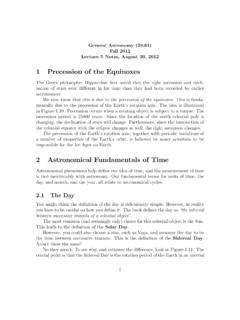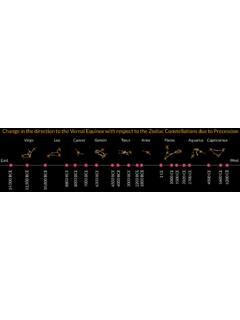Transcription of Astrology from Ancient Egypt - rtulip.net
1 1 Astrology from Ancient Egypt Robert Tulip 30 November 2011 Osiris, Isis, Horus, Thoth, Anubis, Nephthys, Set, Maat, Ra. Names of Egyptian Gods are at the origin of our sense of natural cycles. And yet the meaning of these mythical names is largely unknown. Osiris is the God of the afterlife. With his green skin, Osiris is also a god of fertility, celebrating the return to life each spring after the death of the old year in winter, marked also in Egypt at the rising of the Nile in early summer. Osiris is one of the dying and rising saviours who formed the myth of Jesus Christ in the passion celebration of the annual triumph of light over dark, and of life over death. Easter is connected to the equinox because its natural meaning is the annual change from dark to light at the turning point from winter to spring. Isis, the cosmic mother, the bride of Osiris and virgin mother of Horus, continues today in the form of the Blessed Virgin Mary, adorned with her celestial crown of twelve stars as described in Revelation 12.
2 These twelve stars represent each month of the year in the cycle of the zodiac. Horus, god of the rising sun, son of Isis and Osiris, gave many of his qualities to Jesus Christ. Thoth, God of Wisdom, was a principle source, through his priesthood, of the theology of the word in the gospel of John. Anubis, a god of the dead, was the jackal embalmer who continued as Saint John the Baptist. Nephthys and Set, queen and king of the underworld, morphed into Greek myth in Persephone and Pluto, and continue in Christianity as Martha and Satan. Amun-Ra, God of the Sun, is at the origin of the Judeo-Christian idea of God the Father, whose etymological cognates also stretch to India, through Deus Pater, Jupiter, Zeus Patera and their common origin in the Indian sky god Dyaus Pita. Maat, the Egyptian cosmic order, continued to inspire the New Testament in the name of the Gospel of Matthew. The main Egyptian Gods are shown in the Hall of Judgment.
3 2 Egyptian myth is far closer to us than we often see. Egypt thrived for three thousand years or more as a stable and prosperous kingdom, building immense pyramids and other temples in honour of their worship of the stars and the annual cycle of life. The loss of Egyptian lore, buried beneath the rubble of Christendom, has seen a degradation of human thought, with supernatural dogma replacing the deep wisdom of nature as a basis for community and identity. Not much is known of the detail of Egyptian Astrology , before the Greek invasion, although Egyptian gods were at the centre of the mysteries that embedded the wisdom of the stars. It is unclear how much and what the Greeks borrowed from Egypt , compared to their other main source in Babylon. Illustrating the scale of Greek tribute to Egypt , Euclid of Alexandria, founder of geometry, clearly obtained much of his mathematical knowledge from Egypt , as he lived all his life in that country as a leading Greek in the wake of Alexander s conquest.
4 Ptolemy, whose astrological system provided Western cosmology from early Christian times until Galileo, was Egyptian. Dendera Zodiac An example of Egyptian astronomy is the Dendera Zodiac, from the temple of Hathor on the Upper Nile River, known to date at least to the Greek invasion after Alexander. Now in the Louvre Museum in France, this large sky map shows the stars of the sky, with the zodiac constellations forming a ring around the ceiling, around the rest of the main constellations. Much of the rest of the sky map of Dendera shows an Egyptian code that has not yet been fully deciphered, including the decans around the rim which the Egyptians used to mark every ten days, three per month and 36 in the year, plus the five epagomenal days of the old 365 day calendar of Maat. 3 precession of the equinox , the slow movement whereby the sun shifts its stellar position against the seasons in a cycle of about 25,765 years known as the Great Year, is a theme embedded in Egyptian cosmology.
5 Understanding precession is essential to understanding Egyptian thought, in its ideas and its fate. The Greek astronomer Hipparchus, writing in the second century before Christ, based his estimate of precession of the equinox on Babylonian star records, from observation of the shift of the star Spica in Virgo. We now know that precession is caused by the gravity of the sun and moon applying torque to the equator of the earth, making our planet wobble like a spinning top. The Egyptians did not know the scientific cause of precession , but they were very aware of its effects on the earth in changing observation of the positions of stars over time. The Egyptians were very familiar with precession , although records of Egyptian knowledge of precession are largely lost, except for a few fragmentary ruins and codes. It may yet be possible to reconstruct more of the Egyptian worldview, starting with their approach to precession . Sir Norman Lockyer, founding editor of the leading scientific journal Nature, and discoverer of the second element, helium, is a primary source for beginning to understand Egyptian Astrology .
6 Lockyer s great book, The Dawn of Astronomy Temple Worship in Ancient Egypt , explains how the Egyptians aligned their temples as horizontal telescopes, pointing to the spot on the horizon where they knew a star would rise each night. Temples of Egypt point to the sun, Sirius, Canopus and other bright stars. The heliacal rising of Sirius, the first day each year it becomes visible before dawn, provided the Egyptians with a highly accurate stellar clock of the year over millennia of observation. Their temples were established to observe the cosmos, providing a link between the mundane world and the eternal stars. From the day it first becomes visible at the start of summer, Sirius rises four minutes earlier each night, until in December it is already above the horizon at dusk. Lockyer explains how we know the ancients were aware of the big movement of precession of the equinox well before Greek times. Major Egyptian temples are aligned to the rising point of particular stars.
7 However, due to precession this rising point shifted over the millennia. We see that under and alongside the existing temples, for example at Dendera and Karnak, are foundations of older temples which pointed to where the star was at an earlier time. Lockyer explains how the Egyptians must have noticed that their star temples no longer operated as before. When Sirius rises in the eastern sky, it sends a shaft of light along the long corridor of the temple opening. The early Greek historian Herodotus explained how in Phoenicia, this method was used by priests to light up a large gemstone, an emerald, in the sanctuary of the temple. Over centuries, as the rising point of Sirius shifted, the ritual no longer worked, and the temple had to be torn down and rebuilt on a new axis, pointing to the new position of the star, to maintain the connection between heaven and earth. A scientific paper, On the possible discovery of precessional effects in Ancient astronomy, by Giulio Magli of 4 Dipartimento di Matematica del Politecnico di Milano, explains that the same thing happened on the island of Majorca, where successive layers of ruins point towards the rising position of the Southern Cross, and in other sacred places.
8 The Great Pyramid provides a time lens on the North Celestial Pole, with its tube that formerly pointed to the pole star Thuban in Draco the Dragon. ~ As part of their star worship, the Egyptians observed the night sky carefully for thousands of years in the bright dark desert night. Their close knowledge of the positions of all the stars as markers of time enabled them to see the larger cycles that structure the movement of the earth against the cosmos. These cycles, with the day and year as wheels of time within the big slow wheel of precession , are mentioned by the Old Testament prophet Ezekiel, in his image of wheels within wheels framed by the four living creatures, or angels. These four angels of Ezekiel appear again in Revelation. They mark the four cardinal points of the sky, the zodiac stars Aldebaran in Taurus the Bull, Regulus in Leo the Lion, Antares in Scorpio the scorpion/eagle, and Fomalhaut in Aquarius the man. These four living creatures stand before Osiris in the hall of the dead as the four sons of Horus.
9 They later became the four evangelists around the throne of Christ. They are primary markers of precession of the equinox , having formerly, during the Age of Taurus, occupied the cardinal points where the sun entered each season, moving then through mid season, marking the fixed signs during the Age of Aries, and late season, marking the mutable signs during the Age of Pisces. For example Aldebaran has moved over the last six thousand years from the tropical sign of Aries, through Taurus to its current position in Gemini. It will again enter the cardinal sign of Cancer in the Age of Aquarius. These four stars are now once again approaching the cardinal points of the solstices and equinoxes. In the Age of Aquarius, Fomalhaut will become the northern spring star, occupying the cardinal point of the sky, and likewise Aldebaran will be 5 the star of the summer solstice, Regulus the star of the autumn equinox , and Antares the star of the winter solstice.
10 This sky map of the position of the spring equinox over historic time since the dawn of the Age of Taurus shows Aldebaran, the Eye of the Bull, in the star group called the Hyades Cluster. We see here that Aldebaran was the spring equinox star in about 3000 BC. The upper diagram shows the whole ecliptic. The four stars that became the four living creatures are not marked, but they are each just to the right of the four turning points of the curve, where the ecliptic crosses the equator at the equinoxes and where it is furthest from the equator at the solstices. Here we see the four living creatures surrounding the mandorla of Christ, as King of the Cosmos, in an old stained glass church window with the four evangelists as the four living creatures from Ezekiel and Revelation. Saint Luke is Taurus the bull, Mark is Leo the Lion, Matthew is Aquarius the man, and John is Scorpio the eagle. Jesus Christ sits at the center in a shape called the Vesica Piscis, a feminine symbol formed by two circles whose edges touch their centres, cryptically mentioned in the Bible at John 21:11.









